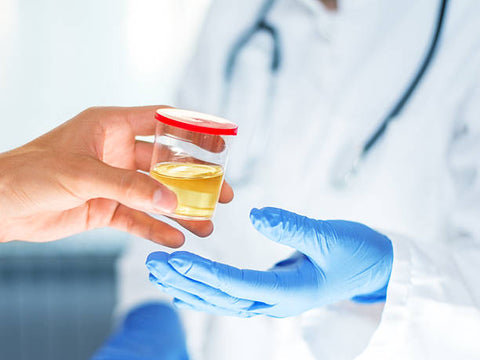Is Modafinil Detectable in Urine and for How Long?
Modafinil is a central nervous system (CNS) stimulant commonly used to treat narcolepsy, sleep apnea, and shift work disorder. Sold as Provigil, it helps reduce excessive sleepiness by stimulating brain areas that regulate wakefulness. For anyone using modafinil, knowing how long it remains in the system is important, particularly in the context of drug testing or possible interactions with other medications.
How Modafinil Works in the Body
Modafinil promotes wakefulness by modulating neurotransmitters such as dopamine, norepinephrine, and serotonin, though its precise mechanism remains incompletely understood (StatPearls, 2025). After oral ingestion, modafinil typically begins working within 30 to 60 minutes, reaching peak blood levels around 1 to 2 hours (FDA, 2015). It primarily targets brain regions like the hypothalamus, hippocampus, and amygdala to enhance alertness.
Pharmacokinetics: Metabolism and Elimination
After absorption, modafinil is processed in the liver and converted into inactive metabolites, mainly modafinil acid and modafinil sulfone, which are then excreted through urine (McKinney et al., 2005; FDA, 2015). Its half-life typically falls between 10 and 15 hours in healthy adults, though factors such as liver function, age, and general health can affect this range (Schwertner & Kong, 2005). Roughly 2 to 5% of the drug is excreted unchanged in the urine (Tseng et al., 2005), an important detail for detection.
Detection of Modafinil in Urine
General Detection Window
Modafinil and its metabolites are detectable in urine for approximately 48 to 72 hours after ingestion, though modafinil acid may be present for up to 4 days (McKinney et al., 2005; Tseng et al., 2005). Factors such as dosage, metabolic rate, and kidney or liver health influence this window.
Detection Methods
Standard drug screening panels typically do not include modafinil, requiring specialized testing when detection is needed. Methods like GC-MS and LC-MS are the gold standards, offering high sensitivity and specificity (Tseng et al., 2005; Schwertner & Kong, 2005). One study using GC-MS reported peak urinary concentrations of unchanged modafinil at 2, 4, and 8 hours post-dose, with detection lasting up to 72 hours (Tseng et al., 2005).
Factors Influencing Detection
Detection duration varies with individual factors such as genetics, organ function, dosage, and frequency of use. For example, impaired liver or kidney function can slow metabolism and excretion, extending detectability (Schwertner & Kong, 2005; FDA, 2015). Higher or repeated doses may also prolong detection times (StatPearls, 2025).
Implications for Athletes and Legal Considerations
Modafinil is classified as a prohibited stimulant by the World Anti-Doping Agency (WADA). Positive drug tests have led to significant consequences for athletes, including the loss of medals, as exemplified by sprinter Kelli White (Taneja et al., 2005). Given this, individuals in regulated sports or professions should be aware of modafinil’s detectability and disclose use appropriately.
Safety, Side Effects, and Interactions
While modafinil effectively promotes wakefulness, it carries potential risks. Common side effects include headache, nausea, anxiety, and insomnia. More severe adverse events like chest pain, rash, and serious hypersensitivity reactions, including Stevens-Johnson Syndrome, have been documented (FDA, 2015). Modafinil can also increase heart rate and blood pressure, warranting caution in patients with cardiovascular conditions (Taneja et al., 2005; FDA, 2015).
Interactions with other CNS stimulants or medications (e.g., steroidal contraceptives) can amplify side effects or reduce effectiveness, and alcohol use should be avoided (FDA, 2015).
Recommendations for Those Undergoing Drug Testing
If subject to drug testing, inform relevant authorities or healthcare providers about modafinil use to prevent misunderstandings or false positives. Understanding the detection window and metabolism can help manage use and avoid unintended legal or professional consequences (StatPearls, 2025; Tseng et al., 2005).
Conclusion
Modafinil remains detectable in urine for up to 3 days post-ingestion, with its inactive metabolite modafinil acid persisting longer. Detection requires advanced analytical methods due to its absence in routine drug panels. Awareness of its pharmacokinetics, detection windows, and potential side effects is critical for users, especially athletes and professionals subject to drug screening. Following prescribed dosages and consulting healthcare professionals ensures safer use and regulatory compliance.
References
- U.S. Food and Drug Administration. (2015). PROVIGIL® (modafinil) tablets, for oral use, C-IV [prescribing information]. U.S. Department of Health and Human Services. https://www.accessdata.fda.gov/drugsatfda_docs/label/2015/020717s037s038lbl.pdf
- Greenblatt, K., & Adams, N. (2023). Modafinil. In StatPearls. StatPearls Publishing. https://www.ncbi.nlm.nih.gov/books/NBK531476/
- Tseng, Y. L., Uralets, V., Lin, C. T., & Kuo, F. H. (2005). Detection of modafinil in human urine by gas chromatography-mass spectrometry. Journal of Pharmaceutical and Biomedical Analysis, 39(5), 1042–1045. https://doi.org/10.1016/j.jpba.2005.04.050
- Schwertner, H. A., & Kong, S. B. (2005). Determination of modafinil in plasma and urine by reversed phase high-performance liquid-chromatography. Journal of Pharmaceutical and Biomedical Analysis, 37(3), 475–479. https://doi.org/10.1016/j.jpba.2004.11.014
- McKinney, A. R., Suann, C. J., & Stenhouse, A. M. (2005). The detection of modafinil and its major metabolite in equine urine by liquid chromatography/mass spectrometry. Rapid Communications in Mass Spectrometry, 19(10), 1217–1220. https://doi.org/10.1002/rcm.1910
- Taneja, I., Diedrich, A., Black, B. K., Byrne, D. W., Paranjape, S. Y., & Robertson, D. (2005). Modafinil elicits sympathomedullary activation. Hypertension, 45(4), 612–618. https://doi.org/10.1161/01.HYP.0000158267.66763.63








